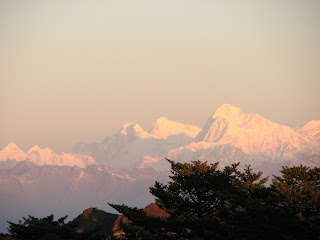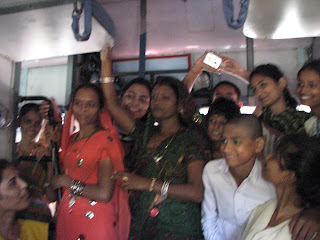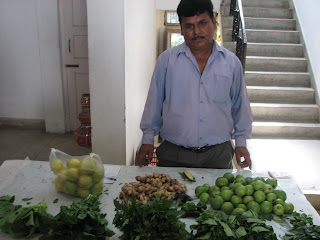December 9th, 2011
Over the past week I completed a course titled “Gandhi and Globalization” at the Navdanya campus. This course brought people from Australia, Japan, California, Sweden, France, and India.. and Montana :) to discuss how Gandhi's teachings can be applied to the uncontrolled growth of globalization. The panels I attended included teachings from Satish Kumar (founder of Schumacher College in the UK), Madhu Suri Prakash (PhD in Philosophy of Education, Penn State), Samdong Rinponcheji (former Prime Minister of Tibet), and Dr. Vandana Shiva. Reflecting on their philosophies is not easy for me as life at Navdanya is somewhat idealist. And while it is easy to follow these ideas in this small, like-minded community, I am torn by the reality of what is actually at home. In short, we discussed that globalization is based on the fact that we are greedy individuals. Gandhi's teachings of Swaraj is realizing the potential of ourselves. By depending on globalized trade, we, as human beings have lost the potential to depend on ourselves and our communities for our necessities. As a result large corporations are ruling the trade market and all of our basic human necessities have been polluted → our air, our water, and our food.
This is where I run into difficulties myself, though, because I am not completely oblivious to some of the good corporations have brought to the world – depending on how you look at it. I can't just go ahead and say all corporations are bad because some of the infrastructure that exists from corporations I, and everyone I know takes advantage of. I guess I just wish that I had a choice as to what is in my drinking water, not to purchase plastics, and how the energy I use is sourced. The only way to do this is to make sure I know my products and to speak up when I don't agree with something. Transparency is honesty and the only way we can control corporate greed and destruction is to demand the transparency we all deserve! I think that questioning our methods of globalization is an important way to not just give into the society that has been created for us.
According to Frances Moore Lappe, we are currently growing enough food to feed the world. However, over one billion people are still going hungry each day and nearly half of these people are farmers. This tells us that the Earth can in fact sustain every living creature, however, the Earth cannot sustain greed. This means that if we are taking more than our fair share, we are stealing from others. This greed leads to anger, corruption, and ultimately competition. Globalization has made people compare themselves to others rather than focusing on what they themselves are capable of. We used to define ourselves by our communities and we each had a role in an interdependent system. However, globalization has changed us to define ourselves by who we used to be (our ancestors) rather than who we are now. We now define ourselves by what we own and who advertising and corporations tell us we should be.
Recently after this discussion we saw the film “The Economics of Happiness” where the effects of globalization are demonstrated. The virtually untouched community of Ladakh in extreme northern India is happy in the fact that they share within their community. Unfortunately, many young people are persuaded to move to urban areas to cash in on these advertisements. How can we warn the children of indigenous cultures that the urban world in fact has nothing to offer them and that we in fact are looking for their knowledge? Also in the film they were showing the affect GM crops had on these indigenous cultures. These corporations make these cultures think they are poor because they could have higher yields with GM seeds and pesticides, versus the practices they have been following for thousands of years. In the end, this technology ends up taking over their lives and they go through a heavy amount of suffering to get out of debt. This begs the question, What does it actually mean to be poor? Has it turned into a choice between community or stuff? To Samdong Rinponcheji there is no “Third World” and “First World” he says, “The world is one, this is a classification of economy and greed”. Of course one person cannot produce everything, though so it is true that trade and waivers must be done. The Samdong Rinponcheji also stated that in ancient times at most a 10% profit was made by trade. Why is it that today we think we need more than this?
From 1999-2002 the Coca-Cola company set up shop in the state of Kerala in southern India. During this period they pumped 2 million liters of water through a reverse osmosis system. This not only left many wells dry but also left behind loads of heavy metals for the local community. This is a sad example of how modern globalization of resources is in the market and not in the community – which in turn leaves people hungry. In the meantime, we are creating a food system in the West that Vandana Shiva describes as, “a food system that wants constipated human beings”. New homes are even being designed without kitchens in response to limited space and our fast food culture – this isn't food!
In the end, one way to become more self-reliant is to look more within the capabilities of the local community. By realizing what you and your community are capable of is a true democratic society. For how can we actually be free if the basic necessities of our lives are out of our hands? Do we have to actually buy seeds to grow food? Seeds have been saved for centuries allowing farmers to spend less on inputs and develop varieties that work specifically in their climates. And do we have to drink water out of plastic bottles? Water, the ultimate basic necessity has always been free but has recently been polluted and stolen by corporations and agricultural chemicals developed for higher yields and higher profits. These are prime examples of how greed is stealing resources that should be available to all. Thank you.
 |
| Vandana Shiva and Myself! |
 |
| Samdong Rinponchej, Vandana Shiva, and Madhu Suri Prakash |









































